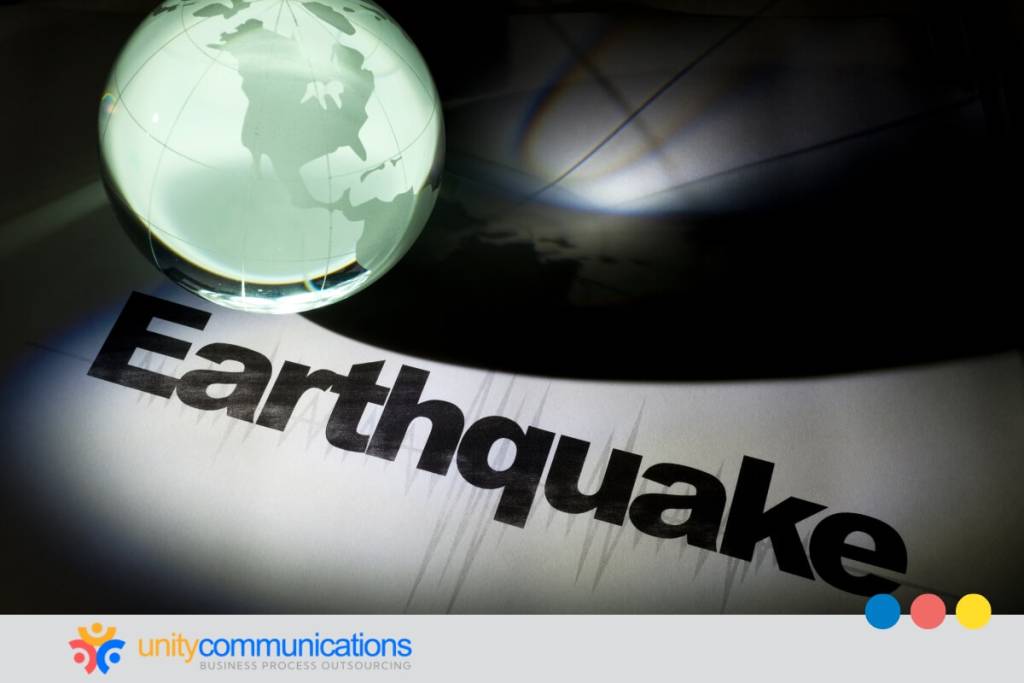Table of Contents
Effective preparedness and response are crucial to minimize loss of life, property damage, and disruption to daily life. Business process outsourcing (BPO) emerges as pivotal in enhancing earthquake resilience.
BPO offers organizations access to specialized expertise and advanced technologies for optimized preparedness and response. For example, 92% of businesses develop and deploy data analytics through external providers.
If you want to learn how BPO teams can help with earthquake preparedness and response services, this article is for you. It explores the different strategies and solutions through outsourcing.
1. Utilizing data analytics and predictive modeling

Data analytics and predictive modeling can provide valuable insights into earthquake risk and vulnerability, improving emergency management. BPO teams can leverage these tools to identify areas of concern, inform decision-making, and improve preparedness and response efforts.
To better understand how it works, it’s best to answer the question: What is BPO?
BPO is the practice of contracting third-party teams to manage non-core functions, utilizing external resources for efficiency and cost reduction.
BPO can provide data analytics and predictive modeling for the earthquake preparedness and response service industry. In fact, Deloitte’s 2022 outsourcing survey shows that 92% of businesses outsource data and analytics capabilities.
Combined with a reliable staff, BPO teams leverage cutting-edge tools for the following tasks:
- Identifying vulnerable areas (e.g., historical data analysis and geographic information systems)
- Assessing infrastructure vulnerabilities (e.g., structural health monitoring and risk assessment models)
- Predicting earthquake occurrence (e.g., early warning systems and seismological data analysis)
- Optimizing resource allocation (e.g., scenario planning, emergency planning, and emergency supply chain optimization)
- Improving response efforts (e.g., real-time data analysis and post-earthquake assessment)
2. Developing comprehensive earthquake preparedness plans
BPO teams can assist earthquake preparedness and response services in developing robust emergency plans beyond basic contingency strategies. Such measures minimize the calamity’s impact, as Taiwan’s earthquake readiness shows. In April 2024, the country had limited casualties despite experiencing a 7.4 magnitude earthquake.
How can BPO teams help create comprehensive earthquake preparedness plans and efficient response services? Here are some tasks they can cover:
- Risk assessment (e.g., identifying specific vulnerabilities within the area, such as critical infrastructure, communication systems, and supply chains)
- Critical infrastructure identification (e.g., determining which assets and resources are essential for your organization’s continued business operations and prioritizing their protection)
- Evacuation procedures (e.g., developing clear evacuation plans for the public, including designated safe zones, evacuation routes, and communication protocols)
- Emergency response procedures (e.g., establishing guidelines for responding to various earthquake scenarios, such as the drop, cover, and hold method and using a fire extinguisher)
- Business continuity planning (e.g., developing strategies to maintain essential business operations during and after an earthquake, including backup systems, remote work capabilities, and contingency plans for critical services)
3. Enhancing emergency preparedness communication systems

Effective communication is critical during and after an earthquake. BPO teams can develop and manage channels as essential communication hubs for earthquake preparedness and response services. These mediums can include:
- Call centers: BPO teams handle incoming and outgoing calls, providing public support, answering inquiries, and disseminating information.
- Chatbots: Artificial intelligence (AI) and BPO often go hand in hand. AI runs chatbots that streamline BPO communication. They can provide instant and personalized responses around the clock during emergencies.
- Social media management: BPO agents use social media to broadcast important information, such as evacuation routes, safety tips, and resource availability.
- Email support: BPO teams manage inquiries about earthquake preparedness and response services through a ticketing system.
- Messaging app: Messaging apps, such as WhatsApp and WeChat, can provide reliable and efficient communication during and after an earthquake.
4. Coordinating multi-agency response efforts
BPO-managed communication channels are also vital in coordinating rescue efforts. They can facilitate collaboration by acting as central command centers.
Here are some primary functions BPO teams manage for the seamless coordination of earthquake preparedness and response services:
Information hub
A BPO team can serve as a central repository for information related to the earthquake, such as:
- Damage assessments (e.g., collecting and organizing information about the extent of damage to infrastructure, buildings, and communities)
- Resource availability (e.g., tracking the availability of resources, such as medical supplies, food, water, and shelter)
- Evacuation plans (e.g., maintaining and updating evacuation plans, including designated safe zones, evacuation routes, and transportation arrangements)
- Resource optimization (e.g., managing the allocation of resources, such as personnel, equipment, and supplies, to deploy them to areas of greatest need)
- Communication channels (e.g., managing communication channels between different agencies and organizations involved in the response)
By collecting and organizing this data, BPO teams can ensure that all relevant parties in earthquake preparedness and response services stay informed with the latest updates.
Coordination of efforts
Outsourcing teams help coordinate the activities of different agencies and organizations involved in the earthquake response. Their functions include:
- Working with stakeholders to define clear objectives and priorities for the response
- Allocating resources efficiently to meet the needs of affected areas
- Mediating disputes or disagreements between different agencies or organizations
- Tracking the progress of response efforts and identifying improvement areas
- Coordinating with insurance companies to ensure they know the situation and can provide necessary support
These BPO efforts align earthquake preparedness and response services with overall objectives.
Crisis management
Earthquakes can often lead to crises, such as supply shortages, communication breakdowns, or security threats. BPO teams can help manage these crises by:
- Identifying and addressing issues to mitigate their impact
- Mobilizing resources and coordinating the activities of different agencies, such as government officials and the American Red Cross, to address crises effectively
- Keeping stakeholders informed about the situation and providing updates on response efforts
- Helping to manage public perception and address misinformation
- Addressing insurance-related issues that might arise during a crisis, such as insurance coverage disputes or claims processing delays
By effectively managing crises, BPO teams can help minimize their impact and ensure that response efforts remain focused on the needs of affected communities.
5. Implementing real-time monitoring and alert systems

As mentioned, BPO teams can help implement real-time monitoring and alert systems through data and analytics. These systems can provide critical information to individuals and communities, allowing them to take timely precautions and potentially save lives.
According to the United Nations Office for Disaster Risk Reduction (UNDRR), countries with limited to moderate early warning coverage have nearly five times more disaster-affected people per capita than countries with substantial to comprehensive coverage.
Some tasks outsourcing agents can cover are:
Data analysis and interpretation
BPO teams can identify potential hazards and earthquake threats by analyzing seismic sensors, GPS stations, and other monitoring devices. Here are a few examples of what they can accomplish:
- Identifying precursor events: Outsourcing agents can analyze data for signs of pre-earthquake activity, such as changes in seismic waves, electromagnetic fields, or animal behavior.
- Assessing earthquake risk: BPO teams can use data analytics to determine the risk of an earthquake occurring in a particular region, allowing for improved preparedness services.
- Detecting seismic anomalies: By monitoring changes in seismic activity, BPO teams can identify unusual patterns that might indicate an impending earthquake.
Alert system development and management
BPO teams can contribute to developing and managing early warning systems, keeping them effective and reliable. They can assist in:
- Defining alert criteria based on the magnitude and location of seismic activity. (e.g., magnitude thresholds, location-based alerts, and shake intensity)
- Developing communication protocols for disseminating alerts to affected populations. (e.g., multiple channels, prioritized groups, custom alerts, and testing and training)
- Coordinating with relevant agencies. (e.g., joint exercises, information sharing, and development of contingency plans)
Alert broadcast
BPO teams can alert affected populations once they can identify an earthquake threat by:
- Utilizing multiple channels: Establishing various communication channels for disseminating alerts, such as mobile apps, social media, and broadcast media
- Prioritizing groups: Identifying priority groups, such as schools, hospitals, and critical infrastructure, that will receive alerts first.
- Customizing alerts: Tailoring alerts based on the location, potential earthquake intensity, and language.
- Testing and training: Regularly testing communication protocols and training personnel on how to respond to alerts.
Integration with existing systems
BPO teams integrate early warning systems with communication infrastructure for better earthquake preparedness services. This ensures that early warnings reach the intended recipients promptly and effectively.
Some strategies outsourcing teams can implement are:
- Integrating with cellular networks (e.g., device-to-device alerts, geo-targeting, wireless emergency alerts, and other emergency services)
- Connecting with emergency response systems (e.g., sharing information, triggering response plans, and coordinating resource allocation)
- Interoperability with other systems (e.g., integrating with weather forecasting systems, interfacing with disaster management agencies, and adhering to standards)
The bottom line
BPO teams can be critical in helping relevant organizations and agencies enhance their earthquake preparedness and response services. They leverage data analytics tools, develop robust readiness plans, streamline communication and coordination, and improve alert systems.
In turn, these help optimize resource allocation and improve decision-making. It also helps mitigate risks and build resilience in the event of an earthquake.
Do you want to learn how outsourcing can help your earthquake preparedness and response organization? Let’s connect and discuss the solutions we offer.




